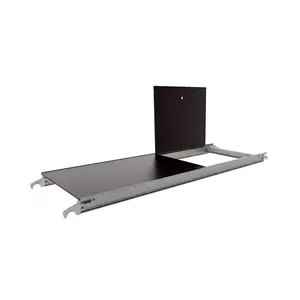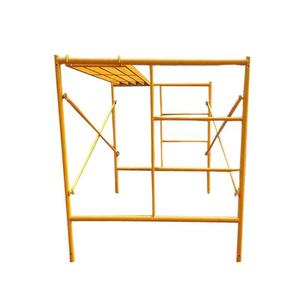Types of access solutions scaffolding
Access Solutions Scaffolding provides temporary structures that support platforms for construction and maintenance projects. They provide access to elevated areas for building workers and are removed when not needed. Access solution scaffolding comes in different types, including:
-
Tube and Fitting Scaffolding
Tube and fitting scaffolding is also called a modular or continuous scaffolding system. It's a common type of access solution scaffolding. It's composed of several components, including; vertical tubes (standards), horizontal tubes (ledgers), and fittings. The vertical tubes provide support and are connected to the ground. The horizontal tubes provide a framework and are connected using right-angle fittings. It's versatile and can be configured for different building projects and heights.
-
Coupler Scaffolding
Coupler scaffolding is a common type of access solutions scaffolding. It's composed of metal tubes and couplers. The metal tubes provide support, and the couplers lock the tubes at the intersection points. The steel tubes are lightweight and transportable, making them easier to carry. This type of scaffolding is cheaper since the materials used are not expensive.
-
Single and Double Scaffolding
Single and double scaffolding are also types of access solutions scaffolding. Single scaffolding is put up on the building's side where masons work. Its standards are fixed in the wall of the building under construction. It consists of ledgers, standards, and transoms. Double scaffolding is erected on both sides of the wall under construction. Its standards are not inserted into the wall since it is deep. Double scaffolding is used when the wall under construction is too deep, and single scaffolding cannot fit.
-
Rolling Scaffolding
Rolling or mobile scaffolding consists of a metal frame, platform, and caster wheels. The metal frame provides a vertical structure, while the platform offers a working area. The caster wheels are under the frame and allow the scaffolding to move. The wheels have brakes that stop the mobile scaffolding from moving. This type of scaffolding is used for projects that require moving the scaffolding from one place to another. It's common in the painting and maintenance industry.
Functions and features of access solutions scaffolding
Access solution scaffolding has numerous applications across diverse sectors due to its key advantages of stability, security, and accessibility. Its main functions involve providing support and a safe working platform for construction activities at elevated heights.
Some of the industries where access solutions are widely used include:
- Construction and Building: Access solution scaffolding is mostly used in the construction sector. It offers a temporary support framework that enables workers to safely reach and undertake tasks on walls, facades, and overhead structures. This is vital for activities like painting, plastering, electrical wiring, and installing windows.
- Maintenance and Repairs: Scaffolding is frequently utilized in the upkeep and repair of structures in different sectors. It provides a stable platform for routine checks, repairs, and maintenance of building exteriors, bridges, and other infrastructure elements.
- Industrial: In manufacturing and industrial settings, especially in factories, plants, and refineries, access scaffolding is used during the setup of machinery, maintenance of processes, and inspection of structures.
- Shipbuilding and Maritime: Scaffolding is a common sight in shipyards and maritime locations, offering support for ship construction, repairs, and maintenance tasks on vessels of any size.
- Events and Entertainment: In the event and entertainment industry, scaffolding provides elevated platforms for lighting, sound systems, stage components, and safe access to elevated areas in concerts, exhibitions, and other events.
- Oil and Gas: In the oil and gas sector, particularly in offshore and onshore facilities, access solution scaffolding provides support for drilling operations, maintenance tasks, and inspections in high-risk and elevated environments.
- Utilities: Scaffolding is used by utility companies to maintain and repair overhead power lines, telecommunication masts, and other utility infrastructures.
- Architecture and Engineering: In architectural and engineering projects, access solutions scaffolding is crucial in constructing, inspecting, and maintaining complex structures, including dams, bridges, and tunnels.
- Residential: Access solution scaffolding is also used in residential settings for construction, maintenance, and repair tasks, especially in multi-story homes and buildings.
Scenarios of access solutions scaffolding
Access solution scaffolding is a temporary structure used in construction and maintenance projects to support work and provide access to elevated areas. Its usage spans various industries and applications, including:
- Construction: Scaffolding is widely used in the construction of new buildings, bridges, and infrastructure projects. It provides a safe and stable platform for workers to perform tasks such as masonry, painting, and installing windows. Access solutions are also used in the construction of tall structures like skyscrapers, cooling towers, and transmission towers. They enable workers to safely reach and work on high-altitude areas.
- Building Maintenance and Repairs: Scaffolding is employed in building maintenance activities such as cleaning, repainting, and window replacement. It allows access to high-rise buildings and ensures maintenance tasks are carried out safely. In the case of damaged structures, scaffolding provides support and stabilizes the building during repair.
- Industrial Facilities: Scaffolding is used in industrial facilities such as refineries, factories, and power plants during construction, maintenance, and inspections. It facilitates access to complex structures and high areas. Additionally, access solutions are utilized in shut-down or turn-around processes in industrial plants, providing access for large teams to complete maintenance tasks efficiently.
- Oil and Gas: Scaffolding is employed in the construction and maintenance of offshore and onshore oil and gas facilities. It provides access to drilling rigs, pipelines, and storage tanks.
- Shipbuilding and Maritime: Scaffolding is used in shipyards during the construction and repair of vessels. It provides access to different parts of the ship's hull and superstructure.
- Events and Entertainment: Scaffolding is employed in the construction of stages, lighting rigs, and sound systems in concerts, festivals, and exhibitions. It provides a safe and stable platform for performers and equipment.
- Manufacturing: Scaffolding is used in some manufacturing processes, such as the construction of large components (e.g., aircraft, wind turbines) that require elevated work platforms.
- Emergency Services: Scaffolding solutions can be used in emergency situations, such as building rescues, disaster response, and emergency repairs. They provide quick and safe access to high areas in critical situations.
- Infrastructure Projects: Scaffolding is used in infrastructure projects such as road construction, tunnel excavation, and railway maintenance. It provides access to high areas and supports workers in challenging environments.
How to Choose Access Solutions Scaffolding
There are several factors to consider when choosing an access solution for a project. Here are some of them:
-
Project Requirements
The first step is to look at the project details. This includes the height and size of the project, the structure and design, and the specific tasks that need to be done. Each project has its own unique needs. So, it is important to assess those needs carefully and match them with the right access solution. For instance, if the project is on a tall building, a scaffolding solution is more suitable. On the other hand, if the project is on a hard-to-reach area, a lifting solution will work better.
-
Safety Standards
Safety should be the main priority when choosing an access solution. All safety regulations and standards should be met to ensure the safety of everyone involved. This includes looking at load capacity, stability features, and safety harness requirements. Consult with safety experts to determine the safest access solution for the project.
-
Cost
Access solutions come with different costs. It is important to look at the overall cost rather than the initial cost. This means considering rental or purchase price and maintenance and operation costs. Scaffolding solutions are more cost-effective for long-term projects. Access solutions are more cost-effective for short-term projects.
-
Ease of Use
The right access solution should be easy to use. This means it should have easy setup and takedown processes. It should also have easy mobility and portability features. This helps save time and improves productivity.
-
Supplier Reputation
The last step is to look at the reputation of the access solution provider. This includes looking at their experience, customer reviews, and quality of equipment. A good provider offers high-quality equipment and excellent customer service.
access solutions scaffolding Q & A
Q1: What are the safety requirements for access solution scaffolding?
A1: Safety requirements for access solution support include:
- Conducting a risk assessment to identify and mitigate potential hazards.
- Ensuring proper scaffolding design and construction following industry standards and regulations.
- Training workers on safe scaffolding practices and procedures.
- Regularly inspecting scaffolding components and structures for stability and integrity.
- Using appropriate personal protective equipment (PPE) such as harnesses, helmets, and gloves).
Q2: What are the types of access solutions?
A2: Types of access solution includes:
- Scaffolding solutions: Temporary structures for elevated work areas in construction and maintenance.
- Access platforms: Elevated platforms, such as cherry pickers or scissor lifts, for safe access to high or hard-to-reach locations.
- Staircases and walkways: Permanent or temporary solutions that provide safe access and egress in elevated or challenging environments.
- Industrial ladders: Robust and safe ladders designed for frequent use in industrial settings, often with added stability features.
- Rope access: Techniques using ropes and harnesses to reach high or difficult areas safely, often employed in maintenance and inspection tasks.
Q3: What are the components of access solution scaffolding?
A3: The components of access solutions include:
- Standards: Vertical pipes that transmit loads to the ground.
- Ledgers: Horizontal pipes that connect standards and provide structural integrity.
- Transoms: Horizontal members that support the platform.
- Platforms: The working surface, often made of timber or metal.
- Braces: Diagonal members that provide stability and rigidity.
- Couplers/Clamps: Fittings that connect and secure the scaffold components.
- Base Plates and Sole Boards: Distribute the load to the ground and provide stability.
- Guardrails and Toeboards: Ensure worker safety by preventing falls and debris.
Q4: What are the risks of access solutions scaffolding?
A4: The risks associated with access solutions include:
- Falls from heights due to insufficient guardrails or safety measures.
- Scaffolding collapsing because of improper assembly or overloading.
- Scalds and burns from hot materials or equipment.
- Electrical hazards from working with power lines or electrical equipment.
- Falling objects and debris that can injure workers below.
- Improper use of ladders and personnel lifts can lead to accidents.
Q5: What are the regulations for access solution scaffolding?
A5: Regulations for access solutions include guidelines on the safe design, construction, and use of scaffolding; requirements for training and certification of scaffold assemblers and users; provisions for regular inspection and maintenance of scaffolding; and specifications for the materials and components used in scaffolding. Compliance with these regulations is essential to ensure the safety of workers and prevent accidents.











































































































































































































